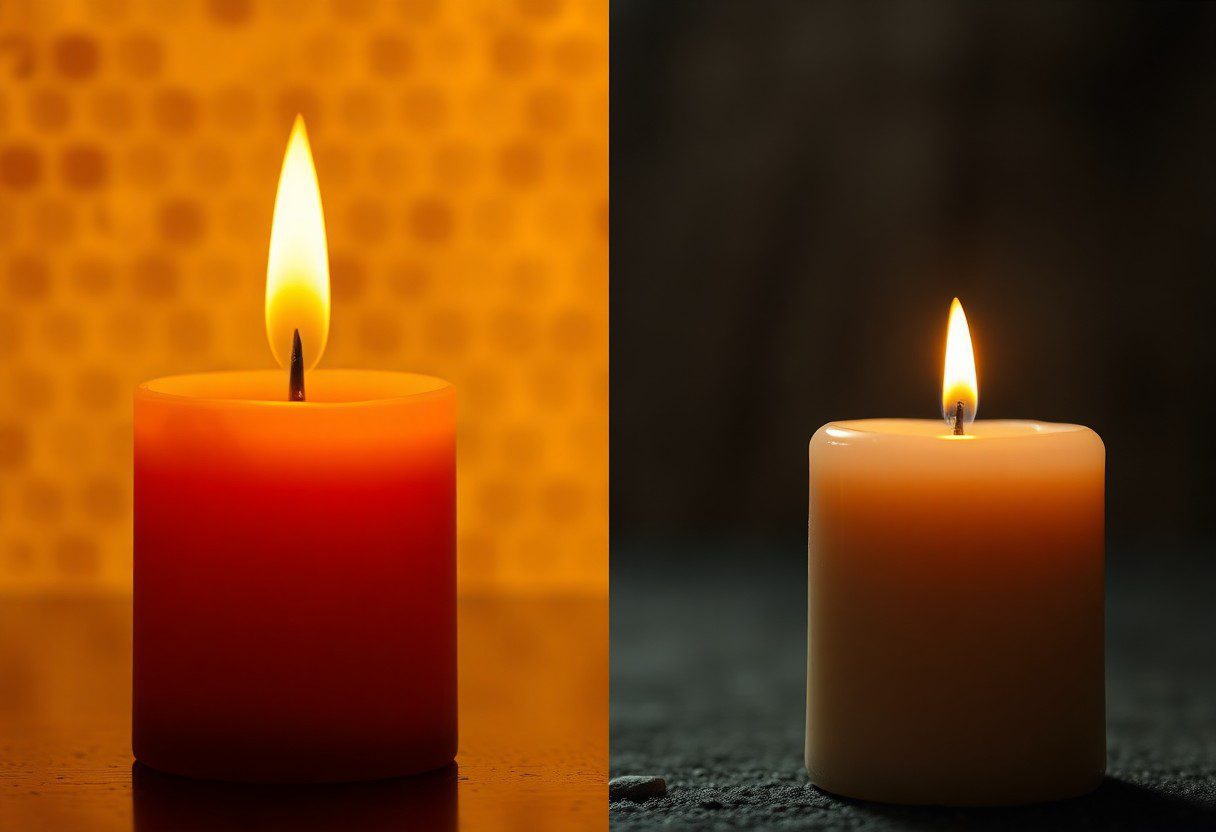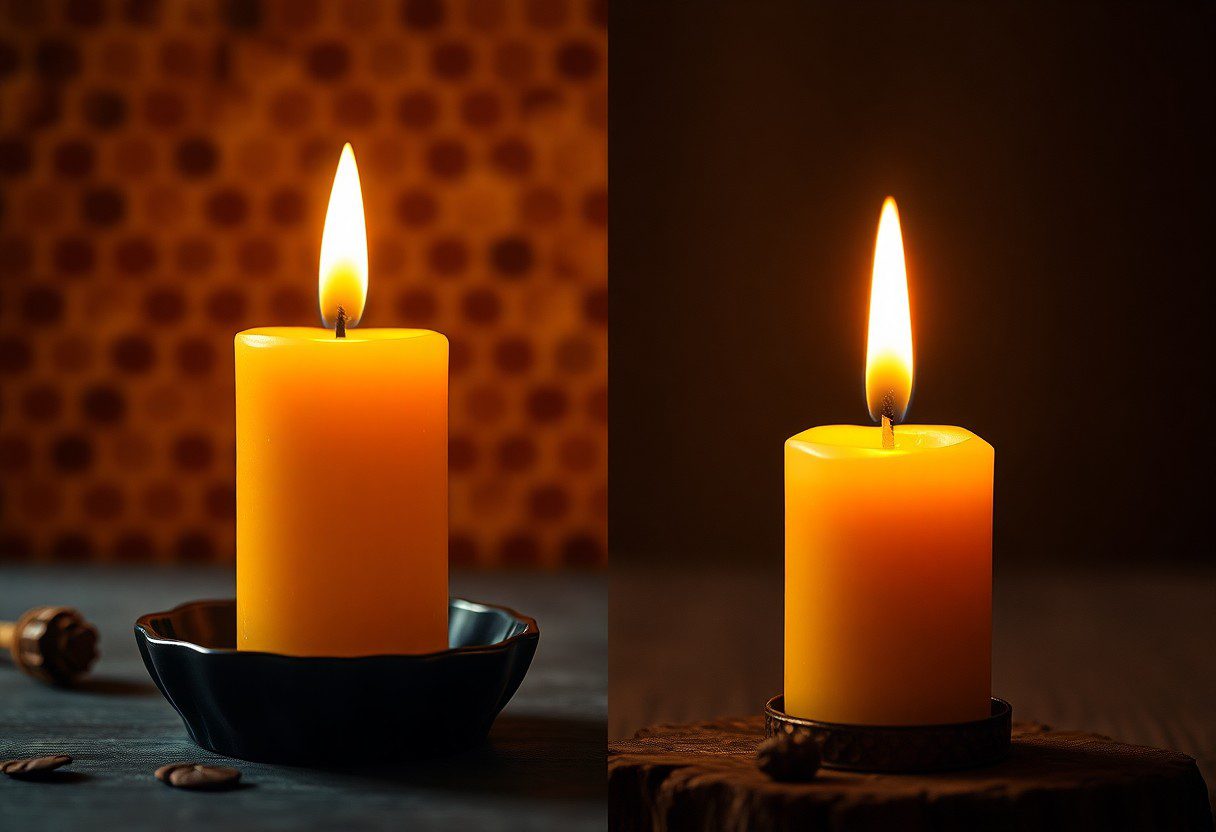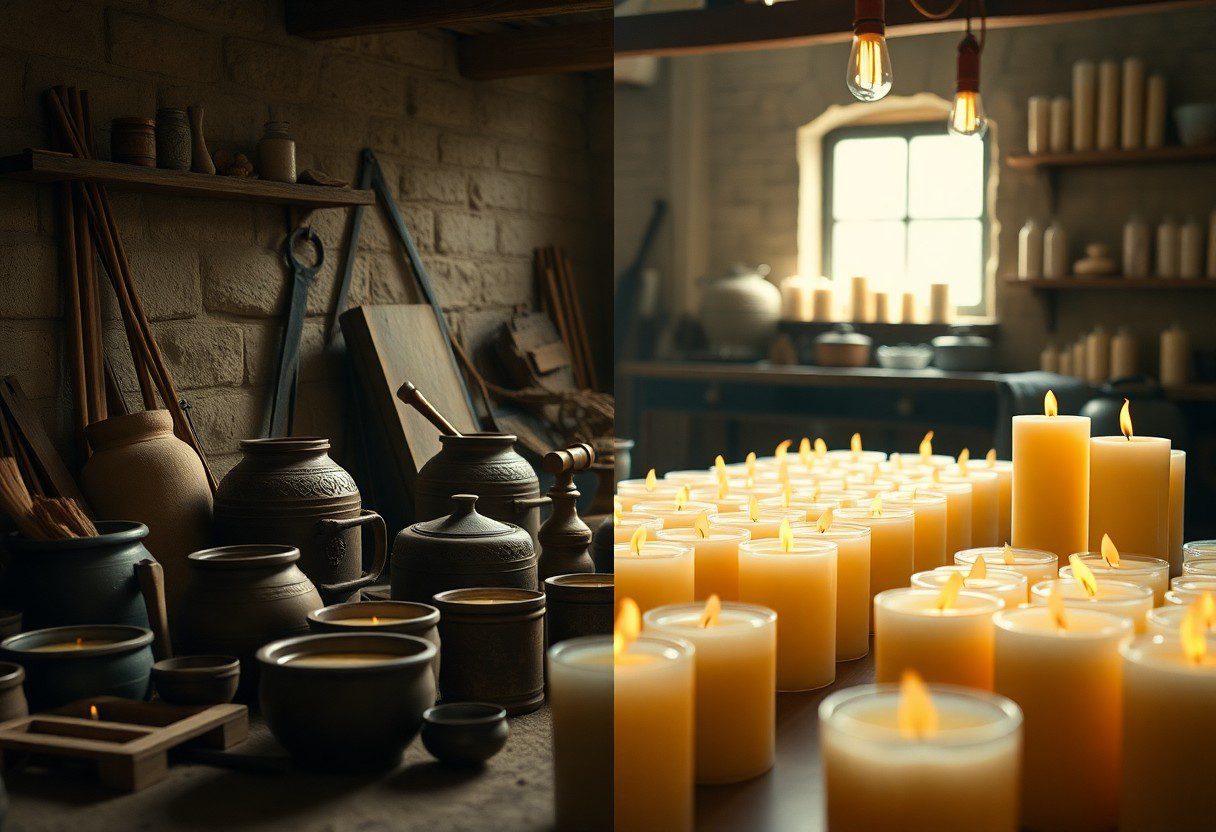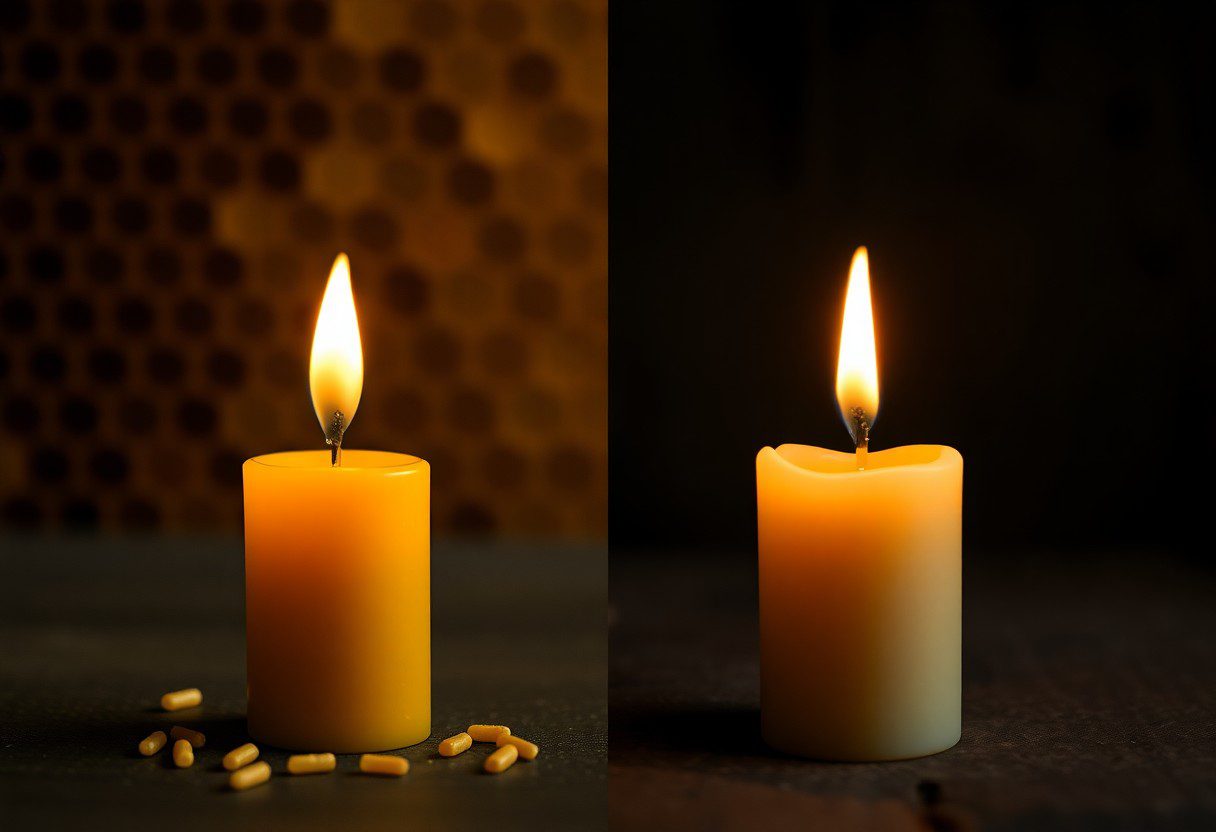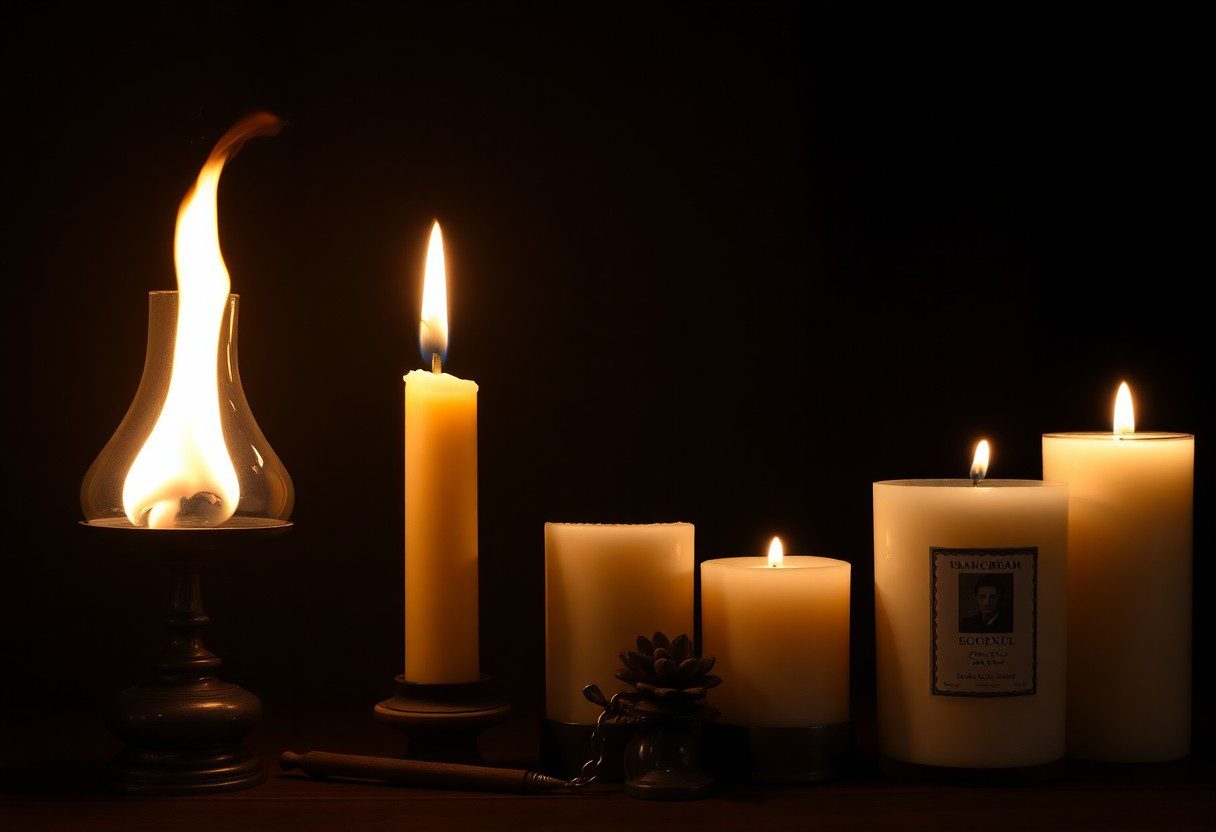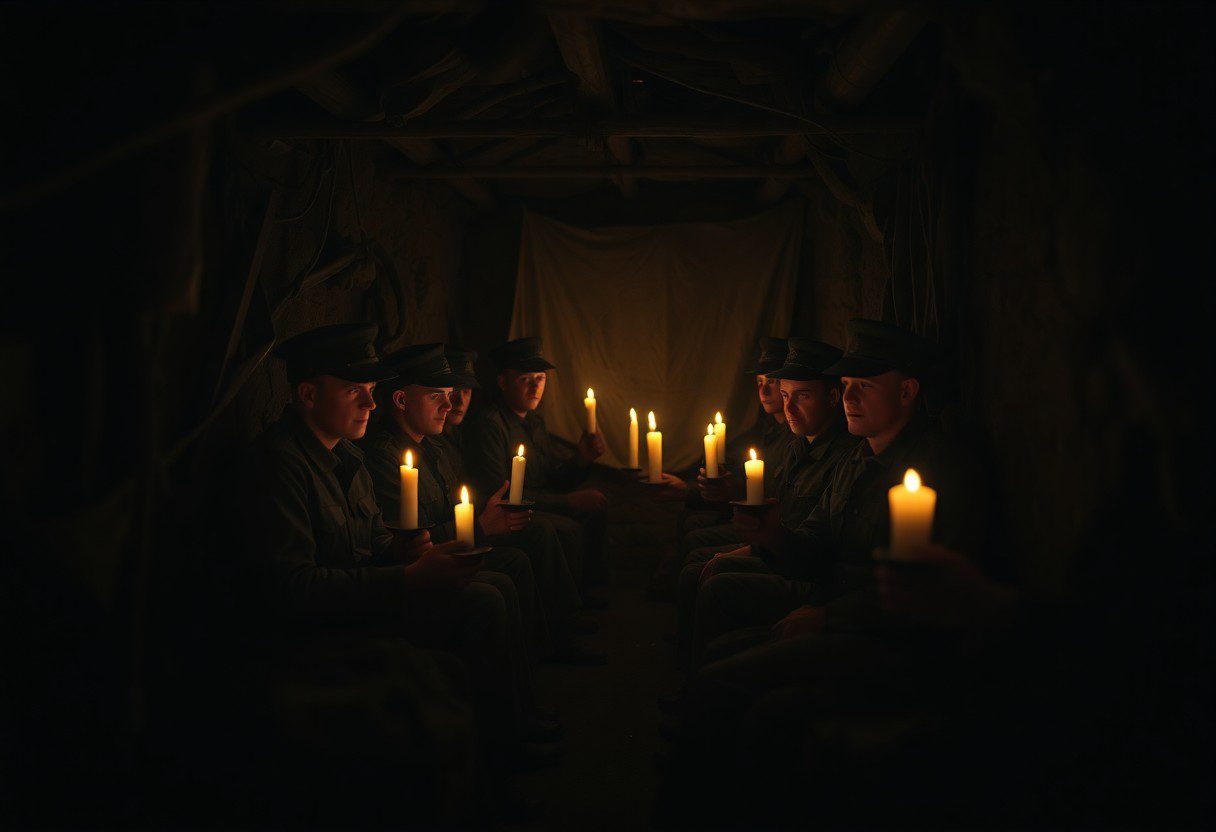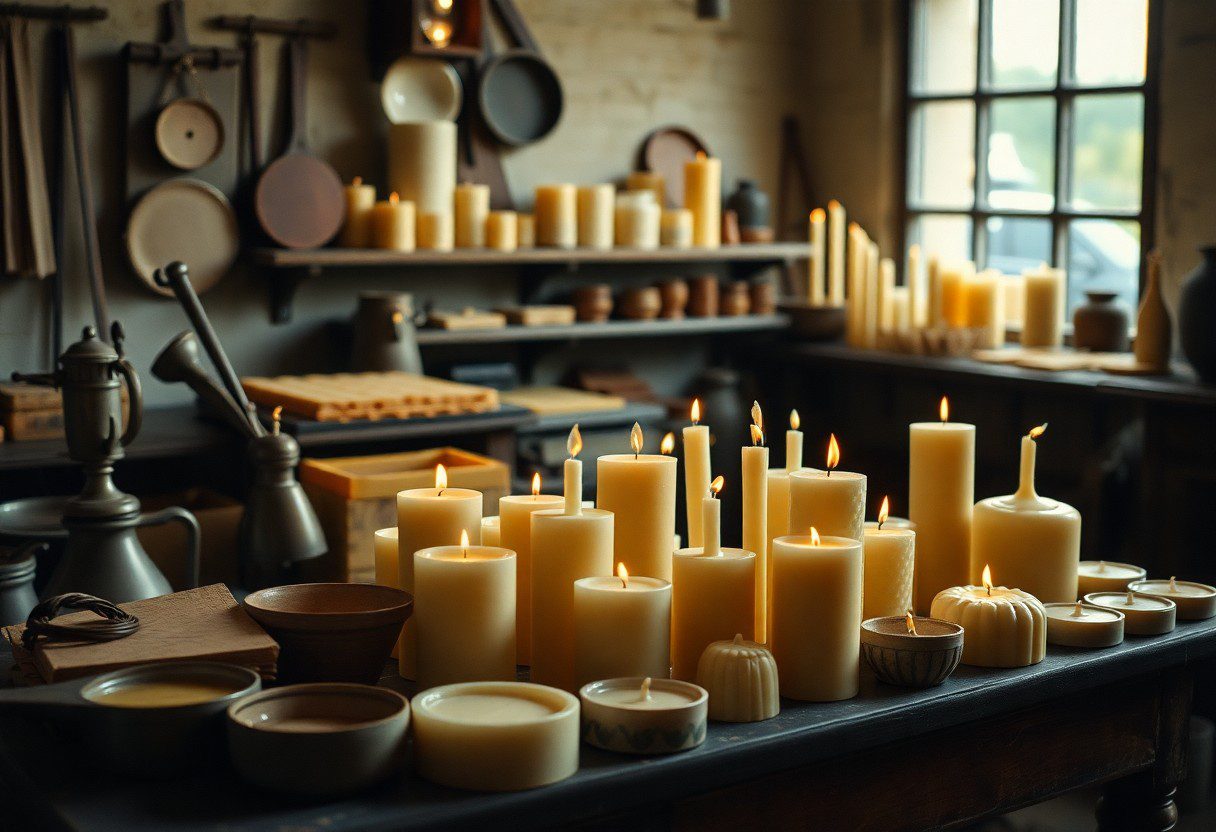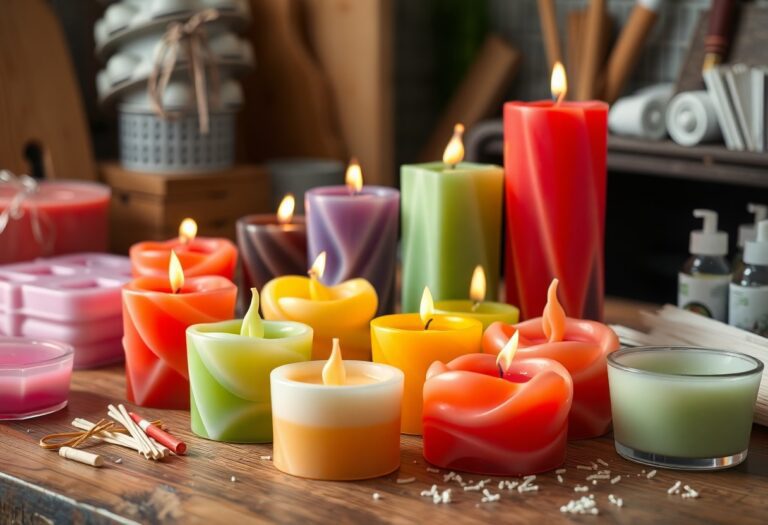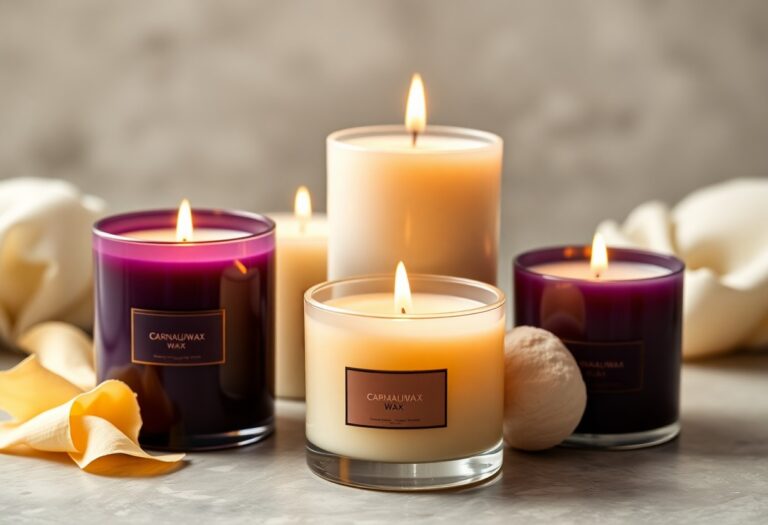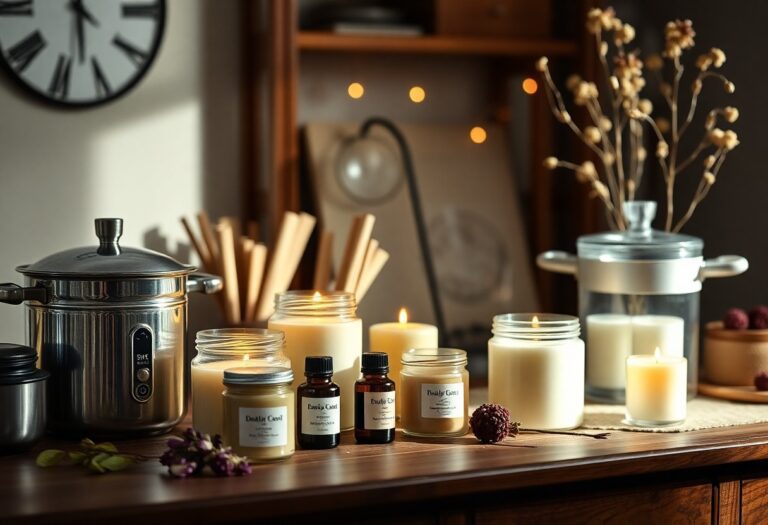Beeswax Vs. Tallow – Understanding The Different Types Of Candles In History
There’s a fascinating journey behind the types of candles you use today, particularly when you explore beeswax and tallow. Each material has played an imperative role in human history, influencing not just illumination but also cultural practices and economic developments. By understanding their unique properties, production methods, and historical significance, you can appreciate the impact these candles had on daily life and rituals of the past. Join me as we examine into the contrasting worlds of these two candle types.
The History of Candle Making
Before modern lighting solutions, candles served as an important source of light for daily activities. Understanding the historical journey of candle making reveals not only the evolution of techniques and materials but also cultural significances and advancements. You will discover that over the centuries, the methods and materials used have not only changed but were largely influenced by availability, technological advancements, and cultural beliefs. From the humble beginnings of simple waxen forms to the complex production of scented and versatile candles today, the journey of candles is interconnected with human progress.
Ancient Uses of Beeswax Candles
Against the backdrop of ancient civilizations, beeswax emerged as a prominent material for candle making. Ancient Egyptians, for example, crafted beeswax candles not only for everyday use but also for religious ceremonies and rituals. You may find it fascinating that they believed these candles could illuminate the way for the soul after death, linking the light to spiritual significance. Beeswax was valued not only for its bright and clean burn but also for the subtle honey aroma it emitted, creating an ambiance that was both soothing and enchanting in various contexts.
The Role of Tallow in Early Candle Production
Beside beeswax, tallow was a widely utilized material in the production of candles from the medieval period onwards. Typically derived from animal fat, tallow was more accessible and cost-effective compared to beeswax, making it the choice of the masses. You will learn that tallow candles were often associated with poorer households due to their lower quality and the unpleasant odors they produced when burned. However, they served a vital role in illuminating homes during long, dark winters. These candles were highly practical, providing light for important tasks, but they also posed hazards since they created soot and smoke, leading to indoor air quality concerns.
The historical reliance on tallow candles reveals a lot about early candle production challenges. The production method was simple and catered to bulk lighting needs, but you should be aware that these candles were often a fire hazard due to dripping wax and smoky flames. In contrast, the less harmful beeswax candles offered a cleaner alternative, although at a higher price point. As you examine deeper into the subject, you will notice how the evolution from tallow to beeswax reflected changing societal values regarding health, accessibility, and the pursuit of quality in your lighting solutions.
Composition and Properties
The composition and properties of beeswax and tallow candles play a significant role in understanding their historical and contemporary use. Beeswax, derived from the secretions of honeybees, is primarily composed of long-chain hydrocarbons, fatty acids, and alcohols. This unique chemical structure gives beeswax its distinctive characteristics, making it a highly valued material in candle making. When you light a beeswax candle, you’re engaging with a substance that has natural antibacterial properties and produces negative ions when burned, which can help purify the air. It’s a fascinating feature that sets beeswax apart from other types of wax.
Chemical Structure of Beeswax
Beside its beautiful golden hue and pleasant honey scent, beeswax consists mainly of myricyl palmitate and other esters. These components contribute to its low melting point and high burning time, allowing for longer-lasting candlelight. When you use beeswax candles, you’ll notice they burn cleaner than paraffin alternatives, resulting in less soot production. The natural composition of beeswax means it doesn’t emit harmful toxins, thus making it an environmentally friendly choice for candle enthusiasts.
Characteristics of Tallow
Properties of tallow candles differ markedly from those made of beeswax. Tallow, derived from the rendered fat of animals, primarily comprises triglycerides, which include a combination of saturated and unsaturated fatty acids. This composition enables tallow to burn with a lower melting point compared to beeswax, but it generally results in a shorter burn time and a higher likelihood of producing smoke when lit. If you decide to use tallow candles, it’s important to note that they can emit a stronger, sometimes less pleasant aroma than beeswax.
Also, while tallow may not deliver the same level of cleanliness in burning, it is a historically significant material that was widely used before the advent of modern candle-making methods. Many people appreciate tallow for its ability to provide a warm, ambient glow, and its affordability compared to beeswax. This historical context adds an intriguing dimension to tallow candles, showcasing their importance as a reliable light source in times long past.
Benefits of Beeswax Candles
Health and Environmental Benefits
Benefits of beeswax candles extend beyond mere illumination; they significantly contribute to your health and the environment. Unlike many conventional candles that release toxic chemicals when burned, beeswax candles are made from natural materials and are known to be non-toxic. When you burn beeswax candles, they emit negative ions that can help neutralize pollutants in your home, improving air quality. This makes them a perfect choice for those with allergies or sensitivities, as they are less likely to trigger adverse reactions.
Moreover, beeswax is a renewable resource, making it an environmentally friendly option. By choosing beeswax candles, you support sustainable beekeeping practices that promote biodiversity. This not only preserves the vital ecosystem elements that bees play in but also ensures that you are making a responsible choice that benefits our planet. Your decision to opt for beeswax can thus have lasting positive impacts on both your health and the environment.
Aesthetic and Performance Advantages
Above all, beeswax candles offer a unique blend of aesthetic appeal and performance that sets them apart from other types of candles. They burn cleaner and longer than most alternatives, allowing you to enjoy your candlelight for extended periods without the worry of soot or smoke. Additionally, you’ll notice that they produce a warm, honey-colored glow that creates a soothing ambiance in any setting. This distinctive look can enhance your home décor and elevate your social gatherings.
In fact, beeswax candles possess natural properties that contribute to their longevity and attractiveness. Their higher melting point means they melt slower, which translates to long burn times. Furthermore, the natural honey scent that wafts from burning beeswax adds a delicate fragrance to your space without the need for synthetic additives. So when you choose beeswax, you’re not just investing in a candle; you’re embracing a remarkable product that enhances both your sensory experience and your environmental contribution.
Benefits of Tallow Candles
Keep in mind that tallow candles offer a variety of benefits that make them an appealing choice for both historical appreciation and practical use. Tallow, derived from the rendered fat of animals, is not only widely accessible but also easy to work with, providing you with an inexpensive and effective lighting option. Historically, these candles were a staple for many households before the rise of more modern candle-making materials. For a deep look into the fascinating evolution of candles through time, you can explore the Museum of Ancient Inventions: Candles. This resource highlights the significance of tallow in past societies and how it shaped their daily lives and industries.
Historical Significance and Accessibility
By understanding the historical significance of tallow candles, you appreciate how they played a pivotal role in providing light during the darker hours of the day. They were more than just a source of illumination; tallow candles were widely accessible due to the availability of animal fat. This affordability made them an crucial part of daily life for the average person, unlike more expensive alternatives such as beeswax. Their simplicity and effectiveness meant that even the most modest households could rely on them, creating a sense of community around shared resources.
Cost-Effectiveness and Use in Survival Situations
Along with their historical relevance, tallow candles provide a significant cost advantage, making them a practical choice in various survival situations. If you find yourself in a disaster scenario or off-grid living, having tallow on hand allows you to create sustainable lighting without relying on commercial sources. The process of rendering animal fat into tallow can easily be learned, making it a skill worth acquiring for anyone interested in self-sufficiency.
Hence, the cost-effectiveness of tallow candles comes from their ability to be made with materials readily available in your environment. Once you become skilled at rendering fat, you will understand that lighting sources don’t have to break the bank. In emergencies, tallow candles can serve multiple functions, such as providing light, generating warmth, and even serving as a means to create makeshift cooking solutions. This versatility makes tallow candles not only a budget-friendly choice but an indispensable asset when resources are limited.
Cultural Significance of Beeswax and Tallow Candles
Despite their practical uses, beeswax and tallow candles hold profound cultural significance throughout history. These candles were not merely sources of light; they played integral roles in various ceremonies and traditions that highlighted their intrinsic value. For example, beeswax candles were often associated with nobility and purity, making them a favored choice for religious rituals and important celebrations. You can explore insights into this rich history at the Smith College Museum of Ancient Inventions: Candles, where you will find how the use of candles has evolved over different periods and cultures.
Religious and Ritual Uses
On many occasions, beeswax and tallow candles have been deeply intertwined with religious practices. In various faiths, the act of lighting a candle represents a connection between the divine and the earthly realm. For instance, beeswax candles are often used in Christian liturgies, symbolizing the presence of Christ as the Light of the World. In contrast, tallow candles were historically utilized in less formal capacities, such as in homes during spontaneous family gatherings or community events. Their accessibility made them practical for everyday use but still crucial in celebrating special moments and marking religious milestones.
Symbolism Across Different Cultures
With a range of meanings attached to them, both beeswax and tallow candles embody various symbols in different cultures. For example, in many societies, the flame of a candle signifies hope, enlightenment, and the transient nature of life. In Eastern cultures, light represents spirituality and is used in meditation to focus the mind and elevate one’s spirit. Additionally, beeswax is often seen as embodying wellness and environmental harmony due to its natural origins, while tallow is associated with resourcefulness and practicality, as it was derived from animal fats available from agricultural practices.
Indeed, the symbolism of candles transcends geographical boundaries. You’ll find that in many traditions around the world, the act of lighting a candle represents an invitation for positive energy and intentions. For example, in Judaism, the lighting of the Shabbat candles brings peace into the home, while in Hinduism, diyas, which may be made from tallow or other materials, are lit during Diwali to symbolize the victory of light over darkness. The cultural narratives attached to both beeswax and tallow candles underscore their enduring importance, showcasing how these simple elements can convey complex ideas about life, spirituality, and the human experience.
Modern Uses and Innovations
After centuries of uses primarily for lighting and religious ceremonies, candles have transformed into versatile products that serve a variety of purposes today. Modern innovations in candle making have expanded the ways in which you can enjoy the warm glow, scent, and ambiance provided by these wax creations. You can find candles infused with imperative oils, designed specifically for aromatherapy, or those featuring intricate designs that double as home decor. Understanding the various types and qualities of candles, such as those made from beeswax or tallow, is imperative for making informed decisions about your purchases, as these factors significantly impact your overall experience and satisfaction.
Current Trends in Candle Making
Above all, the current trends in candle making reflect a heightened awareness of sustainability and personal touch. You may have noticed a surge in interest around eco-friendly options, with many consumers opting for candles made from natural materials like soy wax and beeswax over traditional paraffin. Additionally, there is a growing demand for customized candles, allowing you to select unique fragrances, colors, and containers that resonate with your personal aesthetic and values. This shift signals a broader movement towards individualized and sustainable products that cater to your preferences.
Artisan vs. Mass Production Perspectives
Against the backdrop of rising popularity in handmade candles, the debate between artisan and mass-produced candle makers becomes increasingly relevant. Artisan candles are often crafted with meticulous attention to detail and high-quality ingredients, which may result in richer scents, longer burn times, and unique aesthetics. On the other hand, mass-produced candles tend to be more widely available and less expensive, but they often compromise on quality and perform poorly. You will want to consider your priorities when selecting candles for your home—whether you prefer the character and authenticity of artisan options or the convenience and affordability of mass-produced varieties.
Artisan candle makers often champion the values of craftsmanship and quality that set their products apart. These candles typically utilize natural waxes and premium fragrance oils, resulting in a cleaner burn and a richer olfactory experience. As you explore artisan candles, you may find a deeper connection to the materials and techniques used, providing a sense of participation in a time-honored tradition. Choosing artisan candles can also support small businesses and local economies, adding a layer of ethical consideration to your purchase that you can genuinely feel good about.
To Wrap Up
Hence, understanding the differences between beeswax and tallow candles provides you with a fascinating glimpse into the history of candle-making and the materials used by various cultures. Beeswax, known for its natural purity and delightful honey-like scent, has been a preferred choice for many due to its longer burn time and eco-friendly properties. Alternatively, tallow, derived from animal fat, played a significant role in the daily lives of those in earlier times, offering an accessible source for light before the advent of modern lighting options. Your choice between these two candle types might not only reflect personal preferences but also a deeper appreciation for the historical contexts that shaped their use.
Furthermore, as you explore the rich history behind these materials, you can also consider their modern implications, sustainability, and overall impact on the environment. Understanding these elements empowers you to make informed decisions about your candle usage, whether for ambiance, practical lighting, or as a part of your personal style. Delving into the intricacies of beeswax and tallow allows you to appreciate the craftsmanship and significance of candles throughout history, enriching your own experiences as you illuminate your space.
Q: What are the main differences between beeswax and tallow candles in terms of composition?
A: Beeswax candles are made from the natural wax produced by bees to build their honeycombs. This wax is composed mainly of long-chain fatty acids and esters, giving it a higher melting point and a natural sweet scent. On the other hand, tallow candles are made from rendered animal fat, typically from sheep or cattle. The composition of tallow includes a mix of saturated and unsaturated fats, which can result in a softer texture and a less pleasant odor when burned. Consequently, beeswax candles tend to burn cleaner and longer than tallow candles, producing less soot and smoke.
Q: How did historical uses of beeswax and tallow candles differ?
A: Historically, beeswax candles were often associated with more upscale uses, such as in churches or for special occasions due to their pleasant aroma, clean burning properties, and longer burn times. They were favored for their light quality and were often used in rituals and ceremonies. Conversely, tallow candles were more commonly used in everyday households as they were cheaper and more readily available, though they produced more soot and a stronger odor. Tallow candles were primarily used for general lighting purposes, especially in less affluent communities.
Q: What are the environmental implications of using beeswax versus tallow for candle-making?
A: When considering environmental implications, beeswax candles are often regarded as more sustainable, especially when sourced from responsible beekeeping practices. Beeswax is a renewable resource, and the production of beeswax encourages the maintenance of bee populations, which are critical for pollination. Tallow, although made from animal fat, raises different issues related to livestock farming, including greenhouse gas emissions, land use, and animal welfare concerns. Moreover, sourcing tallow sustainably can be challenging, as it is linked to meat production. Therefore, those looking to minimize environmental impact may prefer beeswax candles over tallow options.

